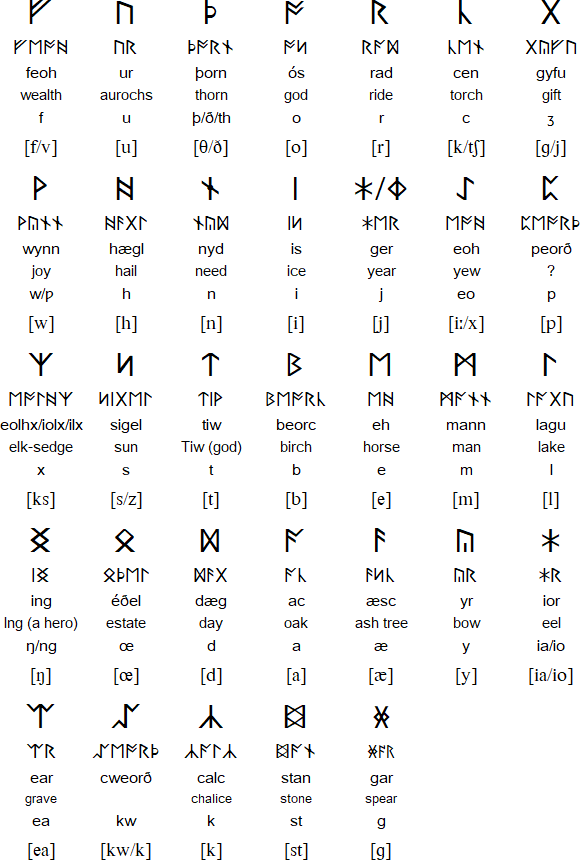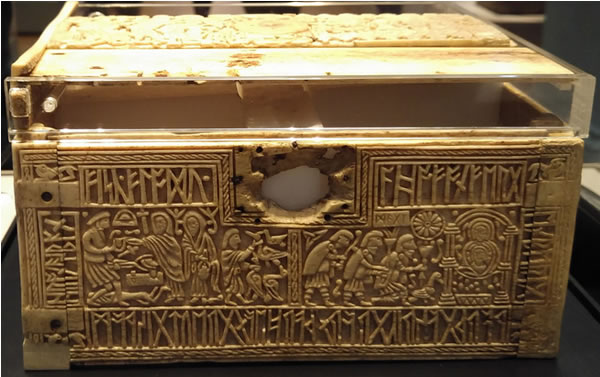
Anglo-Saxon runes (Old English: rūna ᚱᚢᚾᚪ) are runes used by the early Anglo-Saxons as an alphabet in their writing system. The characters are known collectively as the futhorc (ᚠᚢᚦᚩᚱᚳ fuþorc) from the Old English sound values of the first six runes. The futhorc was a development from the 24-character Elder Futhark. Since the futhorc runes are thought to have first been used in Frisia before the Anglo-Saxon settlement of Britain, they have also been called Anglo-Frisian runes. They were likely to have been used from the 5th century onward, recording Old English and Old Frisian.
They were gradually supplanted in Anglo-Saxon England by the Old English Latin alphabet introduced by Irish missionaries. Futhorc runes were no longer in common use by the eleventh century, but The Byrhtferth's Manuscript (MS Oxford St John's College 17) indicates that fairly accurate understanding of them persisted into at least the twelfth century.
History
There are competing theories about the origins of the Anglo-Saxon futhorc. One theory proposes that it was developed in Frisia and from there later spread to Britain. Another holds that runes were first introduced to Britain from the mainland where they were then modified and exported to Frisia. Both theories have their inherent weaknesses, and a definitive answer may come from further archaeological evidence.
The early futhorc was nearly identical to the Elder Futhark, except for the split of ᚨ a into three variants ᚪ āc, ᚫ æsc and ᚩ ōs, resulting in 26 runes. This was done to account for the new phoneme produced by the Ingvaeonic split of allophones of long and short a. The earliest known instance of the ᚩ ōs rune may be from the 5th-century, on the Undley bracteate. The earliest known instances of the ᚪ āc rune may be from the 6th century, appearing on objects such as the Schweindorf solidus. The double-barred ᚻ hægl characteristic of continental inscriptions is first attested as late as 698, on St Cuthbert's coffin; before that, the single-barred variant was used.
In England, outside of the Brittonic Westcountry where evidence of Latin[3] and even Ogham continued for several centuries, usage of the futhorc expanded.[citation needed] Runic writing in England became closely associated with the Latin scriptoria from the time of Anglo-Saxon Christianization in the 7th century. The futhorc started to be replaced by the Latin alphabet from around the 7th century, but it was still sometimes used up until the 10th or 11th century. In some cases, texts would be written in the Latin alphabet, and þorn and ƿynn came to be used as extensions of the Latin alphabet. By the time of the Norman Conquest of 1066, it was very rare and disappeared altogether a few centuries thereafter. From at least five centuries of use, fewer than 200 artefacts bearing futhorc inscriptions have survived.
Several famous English examples mix runes and Roman script, or Old English and Latin, on the same object, including the Franks Casket and St Cuthbert's coffin; in the latter, three of the names of the Four Evangelists are given in Latin written in runes, but "LUKAS" (Saint Luke) is in Roman script. The coffin is also an example of an object created at the heart of the Anglo-Saxon church that uses runes. A leading expert, Raymond Ian Page, rejects the assumption often made in non-scholarly literature that runes were especially associated in post-conversion Anglo-Saxon England with Anglo-Saxon paganism or magic.
Letters
The letter sequence and letter inventory of futhorc, along with the actual sounds made by those letters could vary depending on location and time. That being so, an authentic and unified list of runes is not possible.

Notes
- The vowel sound of eo (ᛇ) is uncertain, as is the pronunciation of cweorð (ᛢ).
- The letter stan (ᛥ) only appears in once in Futhorc writings, and the letters cweorð (ᛢ) and ior (ᛡ) appear only in ABC lists
- The letter ger (ᛡ) is written ᛄ in manuscripts
Sample texts

Transliteration
fisc flodu ahof on fergenberig
warþ gasric grorn þær he on greut giswom
hronæs ban
Translation
The fish beat up the sea(s) on to the mountainous cliff
The king of (?)terror became sad when he swam onto the grit.
Whale's bone
The inscription is a riddle with the answer whale's bone, which is what the casket is made of.
From the Franks Casket. Photo by Simon Ager, taken in the British Museum.

Transltieration (Old English alphabet)

Transliteration (Latin alphabet)
Eall folc weorþaþ frēo and efne bē āre and rihtum ġeboren. Ġerād and inġehyġd sind heom ġifeþu, and hīe þurfon tō ōþrum ōn fēore brōþorsċipes dōn.
Translation (Modern English)
All human beings are born free and equal in dignity and rights. They are endowed with reason and conscience and should act towards one another in a spirit of brotherhood.
(Article 1 of the Universal Declaration of Human Rights)
Further Reading




















Comments
0 comment